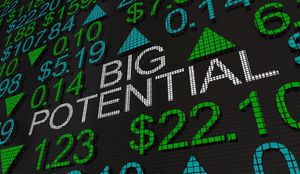Financial News
Gold Shatters Records, Breaches $4,000 Mark Amidst Global Volatility

October 7, 2025 – In an unprecedented financial milestone, gold prices have officially surged past the $4,000 per ounce threshold today, marking an all-time high and sending ripples across global markets. This historic breach underscores gold's enduring appeal as a safe-haven asset, as investors flock to its perceived stability amidst a turbulent economic and geopolitical landscape. The dramatic rally reflects a growing confluence of factors, from persistent inflation fears and central bank buying sprees to escalating international tensions, solidifying gold's role as a critical hedge against uncertainty.
The immediate implications of gold's ascent are profound, signaling a heightened state of anxiety among investors regarding the future trajectory of the global economy. While some see it as a testament to gold's intrinsic value, others view it as a canary in the coal mine, warning of deeper systemic risks. This surge is set to reshape strategies for central banks, institutional investors, and individual savers alike, prompting a reevaluation of portfolio allocations and risk management in an increasingly unpredictable world.
The Golden Tide: A Rally Forged in Uncertainty
The journey to $4,000 an ounce has been a sustained and remarkable one, building significant momentum throughout 2024 and 2025. Last year alone, gold prices climbed approximately 25%, with the London Bullion Market Association (LBMA) gold price setting an astounding 40 new all-time highs and peaking around $2,778 per ounce in late October 2024. The bullish trend continued unabated into 2025, with gold breaking above $3,000 per ounce for the first time in recorded history by March. The upward trajectory accelerated dramatically in recent weeks, pushing prices near $3,900 per ounce by early October, culminating in today's historic breach as gold futures traded at an astonishing $4,005.80 per ounce. This represents a staggering increase of over 50% since the start of 2025, transforming what was once an ambitious forecast into a tangible reality.
Several potent forces have converged to fuel this meteoric rise. Foremost among them is the pervasive geopolitical instability and economic uncertainty, which has amplified gold's traditional safe-haven demand. Ongoing trade disputes, heightened international tensions, and concerns over economic stability – exemplified by events like a recent US government shutdown and political turmoil in nations like France and Japan – have driven investors to seek refuge in gold. Simultaneously, central banks worldwide have engaged in aggressive purchasing, diversifying their reserves away from the US dollar and hedging against potential sanctions or financial instability. This institutional demand has been a significant underlying driver.
Adding to the impetus are persistent inflation fears, which position gold as a classic hedge against the erosion of purchasing power. Despite central bank efforts, lingering inflationary pressures have made gold an attractive asset for wealth preservation. The weakening US dollar has also played a crucial role, making gold more affordable for international buyers and thereby boosting demand. Furthermore, robust investment demand, evidenced by substantial inflows into gold-backed exchange-traded funds (ETFs) reaching their highest levels in over three years in September 2025, underscores widespread investor confidence in the precious metal. The Federal Reserve's pivot to a rate-cutting cycle, with high probabilities of continued reductions through 2025, has created an extremely favorable environment for non-yielding assets like gold, further lowering its opportunity cost.
Initial market reactions have been a mix of exhilaration and cautious analysis. Wall Street analysts from institutions like HSBC, Goldman Sachs (NYSE: GS), and Bank of America (NYSE: BAC) have been consistently revising their gold price forecasts upward, with many now targeting or exceeding the $4,000 mark. However, some sentiment indicators point to "euphoric levels" among retail investors, a condition historically associated with potential market tops. Despite warnings of "uptrend exhaustion" from some analysts, professional money managers, including figures like Ray Dalio of Bridgewater Associates, have increased their gold allocations, emphasizing its unique ability to perform well when other portfolio components falter.
Corporate Fortunes: Winners and Losers in the Golden Era
The unprecedented surge in gold prices creates a clear dichotomy of fortunes across various industries, particularly impacting gold mining companies and the jewelry sector.
Gold mining companies stand to be significant beneficiaries of this rally. Major players like Barrick Gold (NYSE: GOLD), Newmont Corporation (NYSE: NEM), and Agnico Eagle Mines (NYSE: AEM) are experiencing substantial margin expansion, as the soaring price of gold far outpaces their production costs. This improved profitability translates into strengthened balance sheets, record cash flows, and enhanced earnings. The increased financial robustness allows these companies to ramp up growth investments, expand exploration budgets, and re-evaluate development projects previously considered marginal. Furthermore, the sector is witnessing renewed merger and acquisition (M&A) interest, as producers seek to consolidate and secure future production sources. While some analysts note a divergence where mining equities haven't always fully reflected gold's strength, a sustained high-price environment is expected to lead to improved cash flow, higher dividends, and potential stock price appreciation for efficient operators, with significant valuation upside under a continued bullish scenario.
Conversely, the record-high gold prices present considerable challenges for the jewelry industry. Businesses like Tiffany & Co. (NYSE: TIF) (a subsidiary of LVMH Moët Hennessy Louis Vuitton SE, EPA: MC) and Signet Jewelers (NYSE: SIG) face increased costs for their primary raw material, leading to a noticeable decline in consumer demand. Global gold jewelry consumption decreased by 19% year-over-year in March 2025, with major markets like China experiencing substantial drops. Consumers are increasingly shifting towards more affordable alternatives, such as silver or gold-plated items, and in regions like India, there's a growing preference for lightweight and lower-carat gold jewelry (e.g., 18-carat pieces) to manage costs. Jewelers are adapting by focusing on minimalist designs that require less gold and by experiencing a surge in recycling activities, as high prices incentivize consumers to sell existing gold, providing a more cost-effective source of material. These companies are navigating unavoidable price adjustments and strategic pivots to maintain market relevance.
Broader Ripples: Gold's Signal in the Global Economy
Gold's breach of the $4,000 mark is not merely a headline for commodity traders; it carries wider significance for the global financial system and reflects profound shifts in investor psychology and economic fundamentals. This event strongly reinforces gold's role as a critical hedge against market volatility, inflation, and currency devaluation risks, especially in an environment where equities and crypto markets can experience significant fluctuations. It solidifies its position as a reliable store of value with a low correlation to other major asset classes, making it an indispensable component of diversified portfolios.
The rush toward gold is also a potent indicator of escalating systemic risk as perceived by investors. The current market exhibits an unusual "Everything rally," where both traditional risk assets (like certain tech stocks driven by AI advancements) and safe havens (like gold) are simultaneously surging. This phenomenon suggests immense liquidity in the system coupled with underlying anxieties about the stability and sustainability of current growth trajectories. It points to a market caught between the allure of high returns and the imperative of capital preservation, driven by a complex mix of fear and greed.
Historically, sharp rises in gold prices have often coincided with periods of significant economic uncertainty or geopolitical upheaval. Comparisons can be drawn to the gold rallies of the 1970s during periods of high inflation and oil crises, or the post-2008 financial crisis surge. While the specific drivers differ, the underlying theme of gold acting as a refuge from perceived instability remains constant. Regulatory bodies and policymakers will be closely watching gold's trajectory, as its sustained high value could signal persistent inflation concerns or broader economic fragility, potentially influencing future monetary and fiscal policy decisions globally.
The Path Ahead: Navigating the Golden Future
Looking ahead, the trajectory of gold prices will be a critical indicator for both short-term market sentiment and long-term economic stability. In the short term, analysts anticipate a period of potential consolidation or even a minor correction, given the rapid ascent and signs of retail investor euphoria. However, the fundamental drivers—geopolitical tensions, central bank demand, and inflation concerns—are likely to provide strong support, suggesting that any pullbacks could be viewed as buying opportunities. Investors will closely watch central bank communications, particularly from the Federal Reserve, for any shifts in interest rate policy that could impact gold's appeal.
In the long term, the outlook for gold remains robust, especially if the current environment of economic uncertainty and geopolitical fragmentation persists. Gold could continue its role as a primary beneficiary of de-dollarization efforts by central banks and as a hedge against potential currency devaluations. This scenario could lead to further strategic pivots for institutional investors, increasing their allocations to precious metals. Market opportunities may emerge in related sectors, such as gold streaming and royalty companies, which offer leverage to higher gold prices with lower operational risks. Challenges will include managing the volatility that often accompanies record-breaking rallies and assessing the true sustainability of the underlying economic conditions. Potential scenarios range from a continued steady climb, albeit with periodic corrections, to more dramatic spikes if global crises intensify, or a more tempered growth if stability returns.
A Golden Epoch: Key Takeaways and Future Watch
Gold's historic surge past $4,000 an ounce today marks a pivotal moment in financial markets, underscoring its enduring role as a critical safe-haven asset. The rally is a testament to the complex interplay of persistent global economic uncertainty, escalating geopolitical tensions, aggressive central bank buying, and lingering inflation fears. While gold mining companies are poised for significant gains, the jewelry sector faces considerable headwinds, necessitating strategic adaptations.
Moving forward, gold will remain a key barometer of investor sentiment and a hedge against systemic risks. Its current "Everything rally" alongside risk assets highlights a unique market environment characterized by both immense liquidity and underlying anxieties. Investors should closely monitor central bank policies, particularly interest rate decisions, and geopolitical developments, as these will heavily influence gold's future movements. The long-term outlook appears bullish, but short-term volatility should be anticipated.
The significance of this event extends beyond mere price action; it signals a potential reordering of global financial priorities, with capital preservation taking precedence in an increasingly unpredictable world. What investors should watch for in the coming months are signs of sustained central bank demand, any shifts in inflation expectations, and the resolution or escalation of current geopolitical flashpoints. Gold's journey above $4,000 is not just a record; it's a powerful narrative about the state of the world economy.
This content is intended for informational purposes only and is not financial advice.
More News
View More





Quotes delayed at least 20 minutes.
By accessing this page, you agree to the following
Privacy Policy and Terms Of Service.



